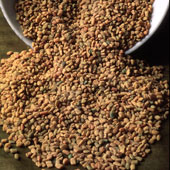Fenugreek
Keywords: fenugreek seed, blood sugar, diabetes

© Steven Foster
On this page:
- Introduction
- What It Is Used For
- How It Is Used
- What the Science Says
- Side Effects and Cautions
- Sources
- For More Information
Introduction
This fact sheet provides basic information about the herbA plant or part of a plant used for its flavor, scent, or potential therapeutic properties. Includes flowers, leaves, bark, fruit, seeds, stems, and roots. fenugreek—common names, uses, potential side effects, and resources for more information. The first recorded use of fenugreek is described on an ancient Egyptian papyrus dated to 1500 B.C. Fenugreek seed is commonly used in cooking.
Common Names—fenugreek, fenugreek seed
Latin Names—Trigonella foenum-graecum
What It Is Used For
- Historically, fenugreek was used for a variety of health conditions, including menopausal symptoms and digestive problems. It was also used for inducing childbirth.
- Today, it is used for diabetes and loss of appetite, and to stimulate milk production in breastfeeding women. It is also applied to the skin to treat inflammation.
How It Is Used
The dried seeds are ground and taken by mouth or used to form a paste that is applied to the skin.
What the Science Says
- A few small studies have found that fenugreek may help lower blood sugar levels in people with diabetes.
- There is not enough scientific evidence to support the use of fenugreek for any other health condition.
Side Effects and Cautions
- Possible side effects of fenugreek when taken by mouth include gas, bloating, and diarrhea. Fenugreek can cause irritation when applied to the skin.
- Given its historical use for inducing childbirth, women should use caution when taking fenugreek during pregnancy.
- Tell your health care providers about any complementary and alternative practices you use. Give them a full picture of what you do to manage your health. This will help ensure coordinated and safe care.
Sources
- Fenugreek. Natural Medicines Comprehensive Database Web site. Accessed on December 28, 2006.
- Fenugreek (Trigonella foenum-graecum L. Leguminosae). Natural Standard Database Web site. Accessed on December 28, 2006.
- Fenugreek seed. In: Blumenthal M, Goldberg A, Brinckman J, eds. Herbal Medicine: Expanded Commission E Monographs. Newton, MA: Lippincott Williams & Wilkins; 2000:130–133.
For More Information
- What's in the Bottle? An Introduction to Dietary Supplements
- Herbal Supplements: Consider Safety, Too
NCCAM Clearinghouse
The NCCAM Clearinghouse provides information on CAM and NCCAM, including publications and searches of Federal databases of scientific and medical literature. The Clearinghouse does not provide medical advice, treatment recommendations, or referrals to practitioners.
Toll-free in the U.S.: 1-888-644-6226
TTY (for deaf and hard-of-hearing callers): 1-866-464-3615
Web site: nccam.nih.gov
E-mail:
CAM on PubMed
Web site: nccam.nih.gov/camonpubmed/
NIH Office of Dietary Supplements
Web site: ods.od.nih.gov
This publication is not copyrighted and is in the public domain. Duplication is encouraged.
NCCAM Publication No. D364
Created March 2007
Updated April 2008
Note: PDF files requires a viewer such as the free Adobe Reader.
